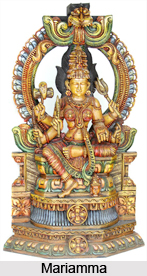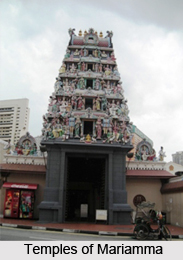 Mariamma is the goddess of smallpox and rain in South India. As a Hindu village goddess, she has female power or Shakti. In the She is highly worshipped in the rural areas of Tamil Nadu, Karnataka, Andhra Pradesh and Maharashtra as the mother goddess. She is also regarded as the fertility goddess. Devotes address her by different names. It is believed by her devotes that the powers of Mariamma are the foundation of life. The goddess is closely associated with the Hindu goddesses Parvati and Durga and also Shitala Devi. Devotees in South India walk miles carrying pots of water mixed with turmeric and neem leaves during the summer months to the goddess. They do so to protect themselves from measles and chicken pox. The goddess is also prayed for the welfare of the family. Devotees offer her "pongal" i.e. a mix of rice and green gram. These are usually cooked with the temple premises in terracotta pots using firewood. During festivals people carry oil lamps in procession.
Mariamma is the goddess of smallpox and rain in South India. As a Hindu village goddess, she has female power or Shakti. In the She is highly worshipped in the rural areas of Tamil Nadu, Karnataka, Andhra Pradesh and Maharashtra as the mother goddess. She is also regarded as the fertility goddess. Devotes address her by different names. It is believed by her devotes that the powers of Mariamma are the foundation of life. The goddess is closely associated with the Hindu goddesses Parvati and Durga and also Shitala Devi. Devotees in South India walk miles carrying pots of water mixed with turmeric and neem leaves during the summer months to the goddess. They do so to protect themselves from measles and chicken pox. The goddess is also prayed for the welfare of the family. Devotees offer her "pongal" i.e. a mix of rice and green gram. These are usually cooked with the temple premises in terracotta pots using firewood. During festivals people carry oil lamps in procession.
Origin of Mariamma
The origin of Mariamma can be dated back to the ancient Dravidian people. She is said to have originated in the in the tribal religion of Dravidian India. She was in vogue much before the arrival of the Aryans and the Brahmin religion. Among the Dravidian mountain tribes as in Coorg in southern Karnataka humans were sacrificed to the goddess to appease her. Presently it has been substituted with animals and birds. In ancient Tamil, the word `Maari` means rain and `amman` means "mother nature." She is thus believed to bring rain and prosperity as the production of vegetation was mainly dependent upon rain. She was not a local deity or associated with any object but deeply worshiped throughout the Dravidian nation. Sometimes she is regarded as the same as Renuka or Yellamma and even Sri Chowdeshwari Devi. Sri Thailuramma Devi, Huchamma Devi, Manchamma Devi, Chwodamma Devi and others. She is thus always regarded as Mother Nature and never related to humans. However, as the goddess is thought to wards off evils and grants prosperity she has always been given a prominent place in religious landscape of South India.
Myths of Mariamma
There are many legends and myths associated with Mariamma. According to one story Mariamma was the wife of Tirunalluvar, the Tamil poet, who was an outcaste. Once she suffered from smallpox and went in search of food from one house to another. She kept fanning her with leaves of the neem or margosa tree to keep the flies off her sores. She then saw that the people worshiped her as the goddess of smallpox. To keep smallpox away they hang neem leaves above the doors of their houses.
Another myth is also associated with her origin. The story is associated with Nagavali, wife of Piruhu, one of the nine Rishis. One day when the Rishi was away the Trimurti came to see her much famed beauty. As she was unaware of their identity she resented their intrusion and in anger turned them into children. The gods became furious and cursed her. Thus her beauty faded and her face became marked like smallpox. When the Rishi returned and saw her ugly face he drove her away. He also cursed her that she would be born a demon in the next world and become the cause the disease which would make people like her. She was called Mari, meaning `changed.`
Iconography of Mariamma
Mariamma is usually portrayed as beautiful young woman with a red hued face, wearing a red dress. In most of her idols she is seen having two or four arms. However, she is also at times carved having many arms portraying her powers. She is usually seen in standing or sitting posture, holding a trident (trisula) in one hand and a bowl (kapala) in the other.  She generally displays abhaya mudra. Mariamma is portrayed with two demeanours. One display her pleasant nature while the other her shows her terrifying feature, with fangs and a wild mane of hair.
She generally displays abhaya mudra. Mariamma is portrayed with two demeanours. One display her pleasant nature while the other her shows her terrifying feature, with fangs and a wild mane of hair.
Temples of Mariamma
There are many temples dedicated to Goddess Mariamma. Most of them are simple village shrines. In most of the temple she is represented as a granite stone with a sharp tip, like a spear head. The idol is then adorned with garlands made of limes and with red flowers. Punainallur, near Thanjavur is a famous temple dedicated to Goddess Mariamma. In Tamil Nadu Erode Mariamman temple festival is celebrated on a grand scale. During the festival three idols small, mid and big of the goddess are installed in three corners of city. It is celebrated in the month of April every year. There are many other temple located in Tamil Nadu are in the towns of Veerapandi, Theni, Anbil, Narthamalai, Thiruverkadu, Salem, Virudhunagar and Sivakasi, Vellore. In Chennai a famous Mariamman temple is the Putthu Mariamman. Other temples are also situated in Karnataka.




















